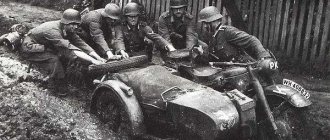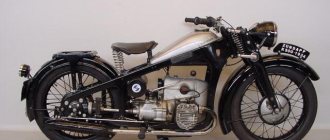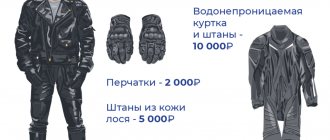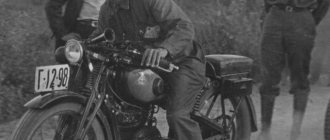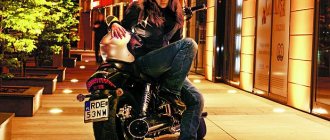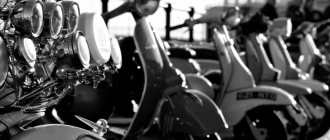Abroad will help us
With the American company Harley-Davidson Motors Co.
from Milwaukee, which has been producing motorcycles since 1903, have been known in our country for a long time. Motorcycles of this brand have been imported to Russia for military and economic needs since tsarist times. After the revolution, they also did not lose popularity, especially since, in fact, they did not have their own motorcycle industry. Even a supporter of the German school of motorcycle building, Petr Mozharov, used an “American type” engine for the domestic IZH-3 and A-750, since BMW boxer engines at that time did not yet have the technical perfection achieved later. Many foreign models of motorcycles were used in our country, but it was Harley-Davidson that was the most respected, and in 1929 a government decree was even issued on the duty-free import of motorcycles from this company.
These motorcycles were intended for the military (primarily pilots) as personal transport, but they were also purchased for the national economy and by private individuals. Neither Indian, nor BSA, nor other foreign (even the best German) models could compare with Harley-Davidson in popularity.
In the USA itself, due to the global crisis among motorcycle manufacturers at the turn of the 1920-1930s. The situation was not going well. If in the mid-1920s. production increased - from 40 thousand in 1925 to 46 thousand in 1927, then in subsequent years it began to fall, and by 1933 it reached a minimum, amounting to 7 thousand units. The following year alone, there was an increase in the production of motorcycles to 10 thousand units. The American motorcycle fleet in percentage terms increased at a slow pace, amounting to: by 1935 - 92,768 units, by 1936 - 98,541 units, by 1937 -104,626 units, and by 1938 - 110,126 units. At the same time, the German motorcycle fleet amounted to 1,582,872 units. - this is about 100 times more than in the national economy of our country.
Thanks to the organization of motorcycle production at a number of factories, the domestic motorcycle fleet in the 1930s. began to gradually increase, although import dependence could not be overcome in full. At the beginning of 1939, there were 22,818 motorcycles in the national economy, and the total fleet, taking into account the army, law enforcement and state security agencies, as well as individual institutions, was estimated at 35 thousand units.
According to the traffic police of the NKVD, the growth of the motorcycle fleet in 1939 amounted to 8,635 units. By January 1, 1940, 31,453 motorcycles were registered in the national economy and among private owners; a year later - already 38,619 units. Although our country's motorcycle fleet was growing at a high rate, the actual volumes did not meet the needs of both the national economy and the military, who considered the motorcycle fleet as a mobilization reserve.
Marshal Kulik on June 15, 1940, in letter No. 16673ss to Marshal Voroshilov, noted that in the states there were a shortage of 26,280 motorcycles with sidecars, and 22,345 without sidecars. As you can see, the overall shortage of motorcycles in the army exceeded the entire motorcycle fleet of the national economy. And this does not take into account the suitability of the existing motor vehicle fleet of the national economy for military purposes.
According to the report “Information on the availability of cars, tractors, trailers and motorcycles in the Red Army at 101.42”, by this time the military had 11,640 units. motorcycles with a requirement of 24104 pcs.
The vast majority of serviceable motorcycles were requisitioned by the military or for the needs of government agencies, and therefore the mobilization reserve was exhausted. Factories were in the process of being evacuated or were militarized. Thus, the plant in Izhevsk stopped producing motorcycles and switched to the production of machine guns. After the evacuation of specialists, documentation and part of the equipment, new motor plants were opened - GMZ (Gorky), IMZ (Irbit) and TMZ (Tyumen), but they could not immediately satisfy the needs of customers. The military needed “single” motorcycles and with sidecars in quantities that were many times greater than the capabilities of the domestic industry. Therefore, the issue of saturating motorcycle parts with new equipment has acquired particular relevance.
American type
By the beginning of the 1930s. Both its main competitor on the continent, Indian, have developed a number of stereotypes in design. In general, American motorcycles were designed for long rides on good quality roads. A mandatory attribute of the American style was spacious footrests for the driver. There was no rear suspension, like almost all motorcycles of that time. The wide arched steering wheel at that time was called “American type”. The engines were constantly improved and, although they were somewhat inferior in specific power and efficiency to advanced European models, they were distinguished by higher reliability and ease of maintenance.
The “American type” engine is a V-shaped two-cylinder 4-stroke engine with a lower valve arrangement according to the SV scheme. The cylinders were placed one after the other, which created certain difficulties with cooling the shaded cylinder. But the transverse crankshaft made it possible to arrange the transmission according to the most common scheme at that time - with a chain drive of the wheel. By the end of the 1930s. a line of engines with a volume of 746, 1208 and 1300 cm3 was introduced.
In our country, given the high popularity of this brand, an attempt was made to master the production of a domestic analogue at a plant in Kharkov, but it was not successful. At plant No. 65 in Taganrog they did not completely copy the American motorcycle, concentrating on developing a domestic analogue of the V-twin engine. In the pre-war period, several samples of motorcycles BM-1200, TIZ-50, TIZ-51 and some others were produced with American-type V-shaped engines.
In 1940, state interdepartmental tests of domestic and foreign motorcycles were carried out. And their results were summed up in the spring of 1941. Simultaneously with the TIZ-50 and TIZ-51 motorcycles, the Harley-Davidson model UH-1300, as well as its Polish and Japanese-made analogues, were tested. The military rejected the TIZ-51 because, along with completely unsatisfactory fuel efficiency, it had a number of other deficiencies that were difficult to eliminate. But TIZ-50 received positive reviews:
“The TIZ-50 motorcycle, with heavy loads and in difficult road conditions, has a higher cross-country ability than a passenger car. In terms of its constructive, dynamic and economic qualities it is at the level of the best foreign brands of this class
Suitable for use as a military vehicle with a crew of 3 people. Can be armed with one of the following types of weapons: a heavy machine gun "DS", a 50 mm company mortar and a backpack flamethrower."
The Sokol motorcycle was developed for the Polish Army from the late 1920s. based on the American Harley-Davidson and Indian. Like the prototypes, the motorcycle was technically outdated and quite heavy, but it turned out to be durable and reliable, and, importantly, it used almost all components and parts made in Poland. Production of Sokol M111 was stopped only by the beginning of World War II.
Regarding the American motorcycle, the test results noted:
“The Harley Davidson motorcycle is not a military model. Ground clearance is 110 mm, does not provide high off-road capability.
The motorcycle has insufficient range /213 km/. Easy to maintain, reliable in operation.
The Japanese army uses the Harley Davidson - 1200 cm3, which differs from a standard motorcycle of the same displacement in the following:
- increased base/1690 mm instead of 1550/
- increased ground clearance/195 mm instead of 110 mm/
- tire size/28×4.75 instead of 27×3.75/
- The trailer stroller has a wheel drive.”
Strictly speaking, Japanese motorcycles were built by Japanese companies under the names, according to the transcription accepted in English-speaking countries, Rikuo and Kurogane, but in our country the Japanese Harley-Davidson was not considered an independent brand. Rikuo and Kurogane were actively used by the Japanese military in China. Several of these motorcycles found their way into the Soviet Union in different ways.
French, German and English motorcycles were also tested. The head of the 2nd department of the ATU GABTU KA, military engineer 1st rank Artemenko, wrote:
“The BSA motorcycle is one of the best English motorcycles in this class, having good dynamic and economic qualities and high cross-country ability.
The cruising range of 192 km is insufficient for this class.
The individual components of the motorcycle: the front fork, the chain drive, are not a perfect design.”
Based on the test results, the German BMW R-71 received the largest number of positive reviews, which was recommended for production instead of the domestic TIZ-50.
BMW R71
It should be noted that, compared to German motorcycles, American ones had a specific location of controls: the clutch pedal was under the left foot, the front brake was on the left side of the steering wheel; the left rotary handle changed the ignition timing. The shift lever was located to the left of the tank. Although at that time there was no uniform standard for the arrangement of levers and pedals, pre-war Soviet motorcycles used in the army (as well as later captured German ones) had similar controls. Therefore, American models were somewhat unusual for our motorcyclists to handle.
With the outbreak of World War II, it received a large order for motorcycles with an engine capacity of about 750 cm3. The new model was designated WLA-42 (the number indicated the year mass production began). It differed from the pre-war WL series with a number of improvements for the sake of military use. The main ones included deeper fenders for better protection from dirt, tires with a developed tread, crankcase breathers that prevented water from getting inside, an inertia-oil type air filter and aluminum cylinder heads. The special equipment included a powerful rear trunk for transporting a radio station, an ammunition box, a case for a Thompson submachine gun (covers were not found on motorcycles available in the USSR), front and rear arches, as well as headlights and taillights with blackout.
During the war years, about 80 thousand WLA-42 were produced, and almost a third of them ended up in the USSR, where our soldiers called it only “Valuy”.
Harley-Davidson WLA-42
A very interesting army model was manufactured in 1941. The motorcycle was conceived primarily for the war in North Africa. Since in the sand the chain was inferior in reliability to the cardan drive, and the rear cylinder of the V-engine was cooled worse, German BMW units with boxer engines served as prototypes for the transmission and power plant. The spark plug suspension of the rear wheel was advanced - like the BMW R-71. A characteristic external feature of the motorcycle are the huge tires measuring 5.50-16″. The designers even made the controls according to the German type: the clutch on the steering wheel on the left, foot shift with a single-arm lever, and the gearbox has four speeds. The seat was on springs. In fact, what remains of a traditional Harley-Davidson is the fork and tank.
HA is a rare specimen, they were released in 1942-1943. a little more than 1000 units, and it did not reach the Eastern Front.
Other original models
The original model of a military motorcycle was developed in Italy. Guzzi presented a tricycle with a machine gun and an armored shield. A feature of this modification was the “dead” placement of the machine gun, directed backwards.
Belgian designers also tried to create something unique in this regard. In 1935, FN presented a simplified model of the M-86. Compared to other European analogues of that time, the car received a number of advantages:
- Forced engine with a volume of 600 cc.
- Reinforced frame.
- Armored front and side sheets.
- Possibility of transporting an armored stroller with a Browning machine gun.
During serial production, over 100 similar copies were produced, operated by the armies of Romania, Brazil, China and Venezuela.
The British are helping
In England, in the first years after the end of the First World War, there was an increase in the production of motorcycles. In 1920, 120 thousand motorcycles were built, the next year - already 140 thousand, and in 1927 production reached its maximum, amounting to 162 thousand units. Such indicators were ensured by the production capacity of weapons factories (it is no coincidence that when developing recommendations for the first five-year plan for the development of peaceful production at the RUZh factories, it was proposed to organize the production of motorcycles following the example of the BSA plant). True, already in 1928 German factories were equal in quantity to British ones, and in 1929 they already produced 201 thousand motorcycles.
In subsequent years, motorcycle production in England declined. True, unlike America, the global crisis did not have such a significant impact on the British motorcycle industry: the minimum production of motorcycles (58 thousand units) occurred in 1933, after which there was some recovery, and in 1937 80 thousand were already assembled. motorcycles.
By the beginning of the Second World War, the British motorcycle industry had become second in Europe after the German one. It included more than two dozen large companies, most of which produced (or could start producing) army motorcycles. Typically, adaptation to military use was limited to installing an additional rear seat, luggage pouches or drawers, and blackout.
If there was no problem of choice with American motorcycles (there were only two companies), then there was plenty to choose from from the British ones. BSA, Matchless, Excelsior and Velossete were offered for supply to our country. It is not known for certain what dictated this choice, because the selected models, except for the BSAWM 20, were not the best among army vehicles at that time. According to the classification accepted at that time, all of them belonged to “medium military” and even “medium road” motorcycles, not designed for use with sidecars. More precisely, it was possible to equip such a motorcycle with a sidecar, but the British motor crew could only carry three soldiers with weapons on a good road and at not the highest speed. English motorcycles had very advanced four-stroke engines of relatively high power for that time due to the use of overhead valve timing and because of the higher compression ratio, but a single-cylinder engine with a volume of 350-500 cm3, even advanced in design, did not provide the motorcycle with characteristics comparable to BMW R-71, M-72 or Harley-Davidson WLA-42.
Another largest supplier of army motorcycles was the British one (Norton): during the Second World War, it produced about 100,000 of them. The WD16H model had a modification with a sidecar wheel drive; it was widely used by the allies for reconnaissance and for transporting ammunition to the front lines, but for some reason the Nortons were not delivered to the USSR under Lend-Lease.
Harley-Davidson
Also popular in recent years is the Harley Davidson army motorcycle with a 350cc two-stroke single-cylinder Rotax engine. This modification is common in various countries of the world and is used as a vehicle for reconnaissance or escort. Among the disadvantages of this model is the use of J-8 fuel, which in composition is more reminiscent of a mixture of diesel fuel and aviation kerosene. This makes it unsuitable for use on gasoline engines. There are exceptions, such as the HDT M103M1 model. The average speed of the device is 55 miles per hour.
Purchase of imported motorcycles
Given the shortage of motorized equipment, with the beginning of the Great Patriotic War, high hopes began to be placed on supplies from the allies. The number one candidate, naturally, was Harley-Davidson.
The impetus for the import of motorcycles was the GOKO Decree No. 110bss of January 4, 1942. It obliged the People's Commissariat of Foreign Trade to purchase 20,000 motorcycles with sidecars from America and England, which were in service with the armies of these countries. At this time, the Second Front had not yet been opened, so it is not surprising that the British government refused to supply motorcycles.
The United States approved deliveries to the Soviet Union, offering motorcycles of the 741-B model. Moreover, if the People's Commissariat for Foreign Trade insisted on models with strollers, the US department categorically refused this.
It should be noted that the Indian motorcycle, created on the basis of the pre-war civilian model Junior Scout, did not fully meet the requirements of the Red Army. It was equipped with an engine that was not powerful enough to drive a sidecar. In addition, the Indian did not have a rear saddle, and the control of the motorcycle was awkward. However, there was no choice. Motorcycles began to arrive through the northern ports of Murmansk and Arkhangelsk to the Soviet Union. Our soldiers immediately dubbed them “turkeys.”
At the end of the same year, the British government nevertheless released a small batch of Velocette motorcycles, the MAF-350 model. They were of the type of light road “single” for work in army conditions, without a trailed stroller, with a passenger in a special rear seat. Despite the small volume of the four-stroke single-cylinder engine, its design was modern - with overhead valve timing, which made it possible to develop power higher than that of the Indiana. The motorcycle was equipped with two luggage bags, allowing the transportation of up to 22 kg of cargo, and was adapted for blackout. Of all the foreign motorcycles, the MAF-350 was the fastest - it could accelerate on the highway to 110 km/h.
Velocette MAF 350
The Allies also supplied a small batch of Matchless motorcycles, and from 1943 they began to import BSA motorcycles of the WM-20 model from England. They were without sidecars, despite repeated requests from the GABTU KA to the NKVT for the shipment of motorcycles with sidecars, more suitable for army needs.
In connection with the start of deliveries of motorcycles from the USA and England, they were tested at the NIABT Test Site. In particular, Harley-Davidson, Indian, Velocette and Matchless were tested. "Harley-Da-Widson" and "Indian", being sidecar models with non-interchangeable wheels, could not show all the inherent qualities of a motorcycle with a sidecar. Their use with sidecars was caused by the necessity and acute shortage of such motorcycles. At the same time, the reliability of Harley-Davidson and Indian was superior to the domestic M-72.
Features of "Ural"
The high dynamics of the military motorcycle, the photo of which is shown above, cross-country ability and maneuverability are ensured by a powerful engine, transmission and chassis. The bike has a base shortened to 1.5 meters, large 19-inch wheels with an all-terrain tread pattern.
The design and layout of the working elements is made according to the automotive principle:
- Motor lubrication system.
- The checkpoint is in a separate block.
- Cardan transmission shaft.
These features guarantee a high level of reliability and maintainability. The working life is increased by observing the use of suitable automotive-type motor and transmission oils.
The Ural combat motorcycle with a trailer has a particularly important parameter for performing combat missions - the ability to overcome obstacles that are beyond the capabilities of most vehicles. With the wheelchair raised, the equipment can move along one track while maintaining balance. This allows you to bypass deep holes and obstacles up to 70 centimeters high. The weight of the motorcycle is 315 kilograms, which makes it possible for the crew to turn the unit over a fallen tree or barrier structure. Speeds of up to 100 km/h provide a high margin of time for maneuvering, while operation of the bike in question is possible in various climatic zones (from – 40 to + 50 degrees).
Delivery and acceptance of imported motorcycles
At the end of 1942, when difficulties arose in the supply of motorcycles through the Northern ports of Murmansk and Arkhangelsk, they found another route - through Iran to Julfa (a city in Azerbaijan) and further to Ordzhonikidze (now Vladikavkaz). Assemblies and parts of disassembled motorcycles, packed in boxes, were transported in cars. Along the way, the motorcycle property was reloaded several times; as a result, the closure was broken, and parts from broken boxes were lost or stolen. The southern route of imported motorcycles caused a lot of trouble for the military representatives of the GABTU KA due to the understaffing of the equipment received, delays in delivery and paperwork. At first, the warehouses of GABTU KA in Julfa and Ordzhonikidze could not cope with the acceptance of property, since a lot of cars and spare parts arrived, transportation was not organized, and many accidents occurred along the way. However, the import of motorcycles from England and the USA gradually improved and by May 1945, 299,444 motorcycles were received.
Post-war revitalization
In 1928, the French military motorcycle Mercier was presented. The front track wheel added originality to this creation. After 10 years, engineer Leêtre created a modernized analogue of this machine, called Tractorcycle, fully equipped with caterpillar tracks.
It was assumed that excellent maneuverability and light armor should provide the model with recognition and success in the military sphere. However, the bike had a number of significant disadvantages:
- Large mass (over 400 kg).
- Low speed setting (up to 30 km/h).
- Poor handling.
- Unstable roads.
Despite the fact that the designers soon added side wheels to the design, the army was never interested in this development.
Stroller problem
As already mentioned, all foreign motorcycles arrived in the USSR without sidecars. Apparently, this was not due to any strategic considerations: there were simply more “single” motorcycles per unit area. In addition, the allies believed that the USSR would be able to quickly launch production of such relatively simple products as strollers. But in fact, Soviet industry faced a serious problem, because it was necessary to organize the production of sidecars not only for imported motorcycles, but also for the newly developed M-72. It is worth noting that the design of the stroller for the M-72 was quite complex and consisted of 872 parts.
Initially, the order for strollers was planned to be placed at the Karacharovsky Mechanical Plant of the People's Commissariat of Public Utilities
RSFSR. According to the resolution of the Central Committee of the All-Union Communist Party of Bolsheviks and the Council of People's Commissars of the USSR dated August 10, 1940 No. P 19/160, this enterprise was entrusted with the production of 100 pieces in 1940. and in 1941 5500 pieces. trailer strollers for “new type” motorcycles. However, until October 1940, the technical documentation had not arrived at the plant, and therefore the head of the People's Commissariat of the RSFSR, V. Makarov, wrote to Marshal Voroshilov:
“All technical documentation (drawings and technical specifications) for the trailed stroller must be submitted to the Karacharovsky plant by Gpavmotoveloprom […]. Glavmotovelprom […] has begun designing a sidecar of the BMW-K-71 model and can provide technical documentation to the Karacharovsky plant after testing the sample and correcting the drawings.
Without technical documentation, the People's Commissariat of the RSFSR is deprived of the opportunity to organize production in the IV quarter of 1940 - 100 pieces. trailed strollers, as well as prepare production for the production of trailed strollers from the beginning of 1941.
Please give instructions […] to ensure the production and transfer to the People's Commissariat of the RSFSR of drawings and technical specifications for the BMW-K-71 stroller no later than December 15, 1940. This will make it possible to prepare production for the production of trailed strollers in 1941.”
However, the Karacharovsky plant never received technical documentation for the strollers in a timely manner and was busy producing other products. After approval of the technical documentation, the order for strollers was transferred to the plant in Gorky. Then he was entrusted with the manufacture of the driveshaft and wheels.
The production plan for sidecars for the plant was established in accordance with the general development plan for the production of M-72 motorcycles with sidecars for 1941 - in quantities of up to 40,000 units. By the beginning of the war, the automobile plant in Gorky had established mass production of strollers and was ready to fully supply motor plants with them. But at first there was a delay in mastering the production of the M-72 motorcycle, later the evacuation of motorcycle factories to the East began, and the need for sidecars turned out to be insignificant. As a result, the plant stopped assembling strollers, switching to the production of tank parts. As a result, the production of motorized carriages decreased in 1942.
Ural M-72
In order to save resources and reduce development time, they decided to equip the imported Harley-Davidson WLA-42 and Indian 741-B with sidecars from the M-72. This was preceded by the development of the leading design bureau of Glavmotoveloprom for attaching the sidecar to Indian motorcycles. Tests with a sidecar showed sufficient maneuverability of an American motorcycle with two soldiers, weapons and ammunition. Later, with the start of deliveries of the WLA-42, parts for attaching the sidecar to Harley-Davidson motorcycles were manufactured. At the same time, having a powerful engine, it was not inferior to the M-72 in cross-country ability and load-carrying capacity, and even surpassed it in reliability.
The production of motorcycle sidecars in Gorky, organized in body shop No. 1 of the plant, was intended for motorcycles AM-600 (produced at TMZ) and M-72 (produced at IMZ, GMZ), restored at BTRZ No. 20, as well as for those assembled from kits and "Harley-Davidson".
However, production capabilities turned out to be very limited, and the issuance of imported motorcycles to the troops in 1944 was mainly delayed due to a lack of sidecars. To improve the situation in the second quarter. In 1944, 80 Red Army soldiers were sent to the plant in Gorky. During the year, the plant operated intermittently and always raised concerns about meeting the plan.
In addition to the M-72 type sidecars, the Valui could be equipped with a sidecar with a 37-mm airborne cannon or designed by the Central Design Bureau of the GSDP. The NKL-46 sidecar was designed by the Central Design Bureau of the GSDP to replace the metal sidecar of the M-72 motorcycle and was manufactured in 1945 in a small pilot batch.
In addition to strollers, American motorcycles were equipped with seats for passengers, which were placed on standard luggage racks. For this purpose, similar products from M-72 were also used.
K-750
The Dnepr military motorcycle of this series was an improved version of the M-72 and was produced in Kyiv since 1958. The car was equipped with an “engine” with a capacity of 750 “cubes”, like other analogues of this series from other manufacturers.
Features and Specifications:
- Motor power – 26 liters. With.
- Improved comfort and reliability.
- The chassis is made with hydraulic shock absorbers.
- The stroller was equipped with rubber springs and a special suspension.
- The increased cross-country ability of the K-750 military motorcycle was ensured by an improved drive mechanism for the cradle wheel.
- With an increase in engine power, fuel consumption decreased by almost one liter.

